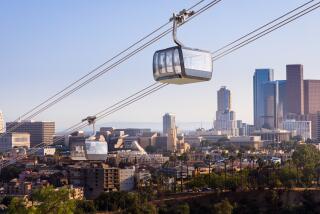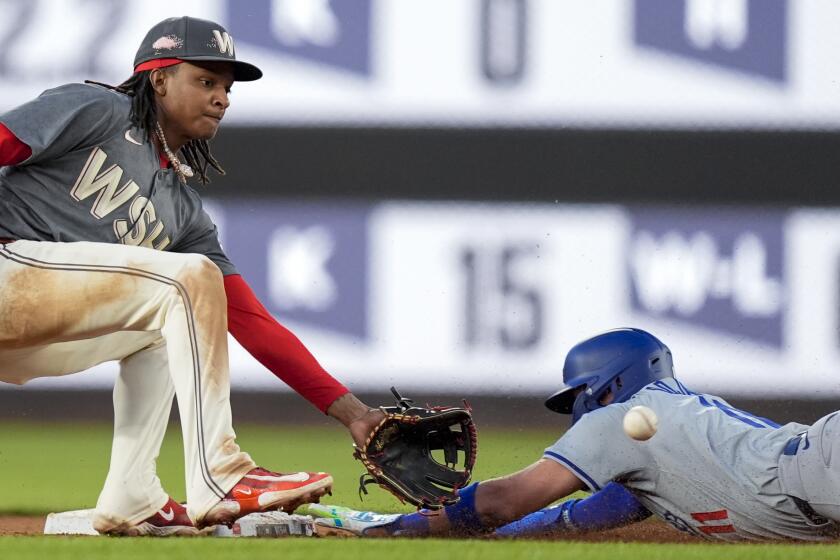Pruning the Rose Bowl with care
While others wilt and wrinkle, or merely go away, the Granddaddy of Them All will march on spryly, with the graying around the temples barely noticeable.
“The Rose Bowl will still be the Rose Bowl 30 years from now,” says Darryl Dunn, chief executive of the group that operates the pride of Pasadena. “That’s our goal.”
This is an era of sports facilities that are labeled tear-downs when they get to be about 30 years old. Forget the past and bring in the jackhammers. Ignore the history and fire up the bulldozers. In general, owners of sports teams — and the cities they play in — prefer shiny and new over historic and charming. The fine-wine concept doesn’t often work for sports facilities.
To be clear, the tear-it-down approach is often the correct one. Many dumps truly earn their status. Example: the still-standing L.A. Sports Arena.
There are exceptions, such as Wrigley Field, Dodger Stadium and Fenway Park. Also, certainly, the Rose Bowl.
There are dangers in attempting to nip-and-tuck aging brick and mortar. They tried that at old Soldier Field and now have a facility referred to by the Chicago Tribune’s architecture critic, shortly after its completion, as “The Eyesore on Lake Shore.” Shortly after the “upgraded” Soldier Field opened, it lost its status as a National Historic Landmark. The Rose Bowl has that status and has no intention of losing it.
Dunn and his Rose Bowl operating group speak proudly of the project and its theory. He says things such as:
— “The Rose Bowl is both a big-time stadium and an old classic stadium.”
— “At the end of the day, after people come to an event, we still want them to feel like they’ve been at the Rose Bowl.”
— “This place has as much history as any sports stadium in the world.”
— “Just because something is old doesn’t mean it is outdated.”
(That last quote was a thinly veiled attempt at getting a column in the paper, but that clearly didn’t work.)
The Rose Bowl has committed $152 million to a project that started this year and will widen the access tunnels; enlarge the press-box area for more luxury suites, club seats and loge boxes; add scoreboards; and widen concourse areas. Seating sections will be divided for easier entrance and departure.
But the look, feel and charm of the Rose Bowl will be kept intact. Example: One of the final touches will be to bring back the hedges that, many years ago, separated the fans from the players along each sideline. How about that for an old-time college football feel?
This is a three-year project. Much of it goes on while the Rose Bowl does business as usual. UCLA will play host to Washington State on Saturday night, and first-time visitors will see signs of construction. All work must be done in time for the 2013 college football postseason. That January, in 2014, the Rose Bowl will not only play host to its historic bowl game, but also the Bowl Championship Series title game. Even more important, that will be the 100th Rose Bowl game.
Dunn says he watched other stadiums come to their demise and knew that a project was needed.
“It was clear,” he says, “that you can’t just sit on your hands. That time will catch up to you.”
The project didn’t take real visual shape until he visited Fenway Park in Boston two years ago and saw how nicely it had been updated, in a way that still preserved its history. He says he has been told that all but one of the bidders for the team in the most recent ownership change had planned to tear the park down and start anew. The group that won the bidding, John Henry’s group, wanted to renovate and preserve, and did so.
Pasadena floated bonds and now a group of civic leaders called Rose Bowl Legacy is raising funds to keep the project going.
There remains, of course, the possibility that an NFL team actually does come to Los Angeles and needs a place to play while either the downtown Farmers Field or Ed Roski’s City of Industry stadium is built. Dunn says that while the Rose Bowl is open to that, it is not counting on it.
“That would be a nice help financially,” Dunn says, “and we are interested in it. But, in that deal, we’re the tail, not the dog.”
Mostly, Dunn wants to keep the Rose Bowl working and viable in the tradition of other major college football stadiums. He cites Michigan and Notre Dame. He also points out that, not long ago, the college bowl season consisted of four majors — the Rose Bowl, Orange Bowl, Cotton Bowl and Sugar Bowl. Now, from the original stadiums that played host to those prestigious games, only the Rose Bowl is still used for its namesake game.
And so, the stadium that has had so many moments is positioned to keep having them.
It is the site of five Super Bowls; of Woody Hayes shoving a camera into the face of a photographer; of Vince Young so memorably running into the end zone; of Chick Hearn and Mel Allen working a broadcast together; of legendary Pop Warner (Stanford) coaching against legendary Knute Rockne (Notre Dame) in a 27-10 Irish Rose Bowl victory in 1925, and of Brandi Chastain scoring the winning World Cup soccer goal for the United States and tearing her shirt off in celebration.
The Rose Bowl is too special not to continue being the Rose Bowl.
“This is more than just a building,” Dunn says.
More to Read
Get our high school sports newsletter
Prep Rally is devoted to the SoCal high school sports experience, bringing you scores, stories and a behind-the-scenes look at what makes prep sports so popular.
You may occasionally receive promotional content from the Los Angeles Times.






